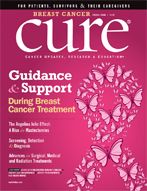Publication
Article
CURE
Considerations for Breast Reconstruction Surgery
Author(s):
Breast reconstruction surgery is common after breast tissue is removed during a mastectomy or, less often, a lumpectomy.
Breast reconstruction surgery is common after breast tissue is removed during a mastectomy or, less often, a lumpectomy. This type of surgery, performed by a plastic surgeon who usually works closely with a breast surgeon, can help restore the look or feel of the natural breast or, in the case of a double mastectomy, breasts. Most public and private insurers are required by federal law to cover reconstructive surgery after a mastectomy.
If mastectomy has been done on only one breast, surgery might rebuild the breast mound to match the size and shape of the natural breast, although surgery may be needed on both breasts to achieve that. The nipple and the areola (the darker area around the nipple) can also be rebuilt. Surgeons can also correct misshapen breasts that may result from breast conservation surgery. In some lumpectomy cases, a reduction and lift is done on the other breast to maintain symmetry, especially if a lot of tissue has to be removed with the lumpectomy.
Breast reconstruction can be done at the same time as mastectomy, after mastectomy and other treatments or in a staged approach in which some aspects of the reconstructive surgery are done at the same time as mastectomy and some are done after. This usually depends on what treatments the woman will need after surgery.
“Both radiation and chemotherapy — but especially radiation — given after surgery are known to affect the reconstructed breast, causing it to lose its shape, for example, or change color, texture and appearance,” says Frederick M. Dirbas, associate professor of surgery at the Stanford University Medical Center in Palo Alto, Calif.
Flap surgery is a type of breast reconstruction that involves taking a section of tissue — skin, fat and/or muscle — from one area of the body and relocating it to create a new breast mound. Part of this surgery can be done during the mastectomy. A second operation will then help shape the breast and perform nipple reconstruction.
Implantation surgery involves inserting breast implants that are filled with saline, silicone gel or a combination of both under the skin of the chest. Saline implants are filled with sterile salt water. They’re inserted empty and then filled once they’re in place. Silicone implants are pre-filled with silicone gel, a thick, sticky fluid that closely mimics the feel of human fat. Some implants are made of a combination of the two — silicone or vegetable oil in the outside chamber and saline on the inside. In many cases, a tissue expander is placed first, then slowly expanded with fluid over the course of several weeks to create space to place an implant with a second surgery later.
After the implant or flap reconstruction has healed, the nipple and areola can be reconstructed. A mound of tissue is made from nearby skin to create a nipple. The areola may be created with a tattoo or by grafting skin from the groin area, which has similar tone as the skin on the areola.
Smokers and women who are overweight have an increased risk of complications for all types of breast reconstructive surgery. Surgeons often recommend delaying breast reconstruction until after quitting smoking or losing weight to lower the risks of these problems.





